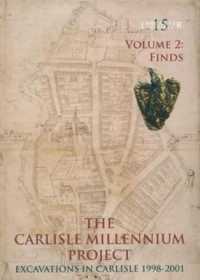Full Description
As the study of embryology continues to be integrated with a range of disciplines, Before We Are Born remains the ideal solution for students who need to quickly learn the basics. Fully updated by the world's foremost embryologists, this medical reference book provides concise guidance on human embryology at every stage of development, utilizing rich illustrations and photographs designed to further explain content.Understand all of the latest advances in embryology, including normal and abnormal embryogenesis, causes of birth defects, and the role of genes in human development. See how discoveries in molecular biology have affected clinical practice, including the development of sophisticated new techniques such as recumbent DNA technology and stem cell manipulation. Prepare for the USMLE Step 1 with clinical case presentations, highlighted in special boxes, which demonstrate how embryology concepts relate to clinical practice.Quickly review just the embryology information you need to know, masterfully distilled from the popular book The Developing Human, written by the same author team. Understand the complex concepts inherent in embryology with help from streamlined content, didactic illustrations, and clinical photos. Test your knowledge with brand-new review questions at the end of each chapter.Searchable, portable, shareable, and perpetual, this Student Consult title offers enhanced features that allow you to interact with your content like never before.
Contents
1 - Introduction to Human DevelopmentImportance of and Advances in EmbryologyDescriptive TermsClinically Oriented Questions2 - Human ReproductionReproductive OrgansFemale Reproductive OrgansMale Reproductive OrgansGametogenesisMeiosisSpermatogenesisOogenesisComparison of Male and Female GametesFemale Reproductive CyclesOvarian CycleMenstrual CycleTransportation of GametesOocyte TransportSperm TransportMaturation of SpermsViability of Oocytes and SpermsClinically Oriented Questions3 - First Week of Human DevelopmentFertilizationPhases of FertilizationResults of FertilizationCleavage of ZygoteFormation of BlastocystClinically Oriented Questions4 - Second Week of Human DevelopmentFormation of Amniotic Cavity, Embryonic Disc, and Umbilical VesicleDevelopment of Chorionic SacImplantation Sites of BlastocytesClinically Oriented Questions5 - Third Week of Human DevelopmentGastrulation: Formation of Germ LayersPrimitive StreakNotochordal Process and NotochordNeurulation: Formation of the Neural TubeNeural Plate and Neural TubeNeural Crest FormationDevelopment of SomitesDevelopment of Intraembryonic CoelomEarly Development of Cardiovascular SystemVasculogenesis and AngiogenesisDevelopment of Chorionic VilliClinically Oriented Questions6 - Fourth to Eighth Weeks of Human DevelopmentFolding of EmbryoHead and Tail FoldsLateral FoldsGerm Layer DerivativesControl of Embryonic DevelopmentEstimation of Embryonic AgeHighlights of the Fourth to Eighth WeeksFourth WeekFifth WeekSixth WeekSeventh WeekEighth WeekClinically Oriented Questions7 - Fetal Period: The Ninth Week to BirthHighlights of Fetal PeriodNine to Twelve WeeksThirteen to Sixteen WeeksSeventeen to Twenty WeeksTwenty-One to Twenty-Five WeeksTwenty-Six to Twenty-Nine WeeksThirty to Thirty-Eight WeeksExpected Date of DeliveryFactors Influencing Fetal GrowthProcedures for Assessing Fetal StatusUltrasonographyDiagnostic AmniocentesisChorionic Villus SamplingCell CulturesPercutaneous Umbilical Cord Blood SamplingMagnetic Resonance ImagingFetal MonitoringAlpha-Fetoprotein AssayNoninvasive Prenatal DiagnosisNeonatal PeriodClinically Oriented Questions8 - Placenta and Fetal MembranesPlacentaDeciduaDevelopment of PlacentaFetomaternal JunctionIntervillous SpaceAmniochorionic MembranePlacental CirculationParturitionStages of LaborPlacenta and Fetal membranes after BirthUmbilical CordAmnion and Amniotic FluidSignificance of Amniotic FluidUmbilical VesicleSignificance of Umbilical VesicleAllantoisMultiple PregnanciesTwins and Fetal MembranesOther Types of Multiple BirthsClinically Oriented Questions9 - Body Cavities, Mesenteries, and DiaphragmEmbryonic Body CavityMesenteriesDivision of Embryonic Body CavityDevelopment of DiaphragmSeptum TransversumPleuroperitoneal MembranesDorsal Mesentery of EsophagusMuscular Ingrowth from Lateral Body WallsPositional Changes and Innervation of the DiaphragmClinically Oriented Questions10 - Pharyngeal Apparatus, Face, and NeckPharyngeal ArchesPharyngeal Arch ComponentsPharyngeal PouchesDerivatives of Pharyngeal PouchesPharyngeal GroovesPharyngeal MembranesDevelopment of Thyroid GlandDevelopment of TongueLingual Papillae and Taste BudsNerve Supply of TongueDevelopment of Salivary GlandsDevelopment of FaceDevelopment of Nasal CavitiesParanasal SinusesDevelopment of PalatePrimary PalateSecondary PalateClinically Oriented Questions11 - Respiratory SystemDevelopment of LarynxDevelopment of TracheaDevelopment of Bronchi and LungsMaturation of LungsClinically Oriented Questions12 - Alimentary SystemForegutDevelopment of EsophagusDevelopment of StomachDevelopment of DuodenumDevelopment of Liver and Biliary ApparatusDevelopment of PancreasDevelopment of SpleenMidgutRotation of Midgut LoopCecum and AppendixHindgutCloacaAnal CanalClinically Oriented Questions13 - Urogenital SystemDevelopment of Urinary SystemDevelopment of Kidneys and UretersPositional Changes of KidneysChanges in Blood Supply of KidneysDevelopment of Urinary BladderDevelopment of UrethraDevelopment of Suprarenal GlandsDevelopment of Genital SystemDevelopment of GonadsDevelopment of Genital DuctsDevelopment of External GenitaliaDevelopment of Inguinal CanalsRelocation of Testes and OvariesDescent of TestesDescent of OvariesClinically Oriented Questions14 - Cardiovascular SystemEarly Development of Heart and Blood VesselsDevelopment of Veins Associated with Embryonic HeartPharyngeal Arch Arteries and Other Branches of the Dorsal AortaFate of Vitelline and Umbilical ArteriesLater Development of HeartCirculation through Primordial HeartPartitioning of Primordial HeartChanges in Sinus VenosusPrimordial Pulmonary Vein and Formation of Left AtriumPartitioning of Primordial VentriclePartitioning of Bulbus Cordis and Truncus ArteriosusDevelopment of Cardiac ValvesConducting System of HeartBirth Defects of Heart and Great VesselsDerivatives of Pharyngeal Arch ArteriesDerivatives of First Pair of Pharyngeal Arch ArteriesDerivatives of Second Pair of Pharyngeal Arch ArteriesDerivatives of Third Pair of Pharyngeal Arch ArteriesDerivatives of Fourth Pair of Pharyngeal Arch ArteriesFate of Fifth Pair of Pharyngeal Arch ArteriesDerivatives of Sixth Pair of Pharyngeal Arch ArteriesPharyngeal Arch Arterial Birth DefectsFetal and Neonatal CirculationFetal CirculationTransitional Neonatal CirculationDerivatives of Fetal Vessels and StructuresDevelopment of the Lymphatic SystemDevelopment of Lymph NodesDevelopment of Spleen and TonsilsClinically Oriented Questions15 - Musculoskeletal SystemSkeletal SystemDevelopment of Cartilage and BoneHistogenesis of CartilageHistogenesis of BoneDevelopment of JointsFibrous JointsCartilaginous JointsSynovial JointsDevelopment of Axial SkeletonDevelopment of Vertebral ColumnCartilaginous Stage of Vertebral DevelopmentBony Stage of Vertebral DevelopmentDevelopment of RibsDevelopment of SternumDevelopment of CraniumDevelopment of Appendicular SkeletonMuscular SystemDevelopment of Skeletal MuscleDevelopment of Smooth MuscleDevelopment of Cardiac MuscleDevelopment of LimbsEarly Stages of Limb DevelopmentFinal Stages of Limb DevelopmentCutaneous Innervation of LimbsBlood Supply of LimbsClinically Oriented Questions16 - Nervous SystemDevelopment of Nervous SystemDevelopment of Spinal CordDevelopment of Spinal GangliaDevelopment of Spinal MeningesPositional Changes of Spinal CordMyelination of Nerve FibersBirth Defects of Spinal CordDevelopment of BrainBrain FlexuresHindbrainMyelencephalonMetencephalonChoroid Plexuses and Cerebrospinal FluidMidbrainForebrainCongenital Anomalies of BrainDevelopment of Peripheral Nervous SystemSpinal NervesCranial NervesDevelopment of Autonomic Nervous SystemSympathetic Nervous SystemParasympathetic Nervous SystemClinically Oriented Questions17 - Development of Eyes and EarsDevelopment of Eyes and Related StructuresDevelopment of RetinaDevelopment of Choroid and ScleraDevelopment of Ciliary BodyDevelopment of IrisDevelopment of LensDevelopment of Aqueous ChambersDevelopment of CorneaDevelopment of EyelidsDevelopment of Lacrimal GlandsDevelopment of EarsDevelopment of Internal EarsDevelopment of Middle EarsDevelopment of External EarsClinically Oriented Questions18 - Integumentary SystemDevelopment of Skin and AppendagesEpidermisDermisDevelopment of GlandsDevelopment of HairsDevelopment of NailsDevelopment of Mammary GlandsDevelopment of TeethBud Stage of Tooth DevelopmentCap Stage of Tooth DevelopmentBell Stage of Tooth DevelopmentTooth EruptionClinically Oriented Questions19 - Human Birth DefectsTeratology: Study of Abnormal DevelopmentBirth Defects Caused by Genetic FactorsNumerical Chromosomal AbnormalitiesStructural Chromosomal AbnormalitiesBirth Defects Caused by Mutant GenesBirth Defects Caused by Environmental FactorsPrinciples of TeratogenesisHuman TeratogensEnvironmental Chemicals as TeratogensInfectious Agents as TeratogensRadiation as a TeratogenMaternal Factors as TeratogensMechanical Factors as TeratogensBirth Defects Caused by Multifactorial InheritanceClinically Oriented Questions20 - The Cellular and Molecular Basis of DevelopmentIntercellular CommunicationGap JunctionsCell Adhesion MoleculesMorphogensRetinoic AcidTransforming Growth Factor-ss/Bone Morphogenetic ProteinSonic HedgehogWnt/ss-Catenin PathwayReceptor Tyrosine KinasesCommon FeaturesRegulation of Angiogenesis by Receptor Tyrosine KinasesNotch-Delta PathwayTranscription FactorsHox/Homeobox ProteinsPax GenesBasic Helix-Loop-Helix Transcription FactorsEpigeneticsDNA MethylationHistone ModificationsStem Cells: Differentiation versus PluripotencySummary of Common Signaling Pathways Used during DevelopmentBibliography and Suggested ReadingAnswers to Clinically Oriented QuestionsIndex








